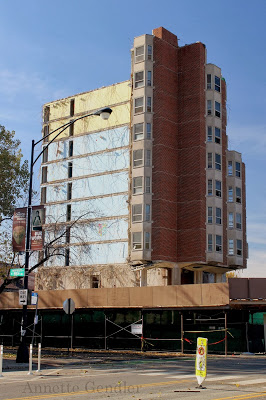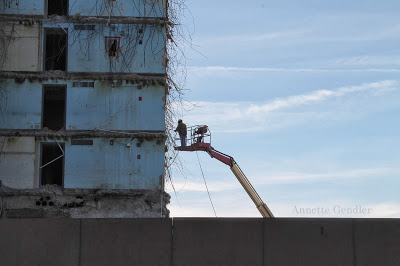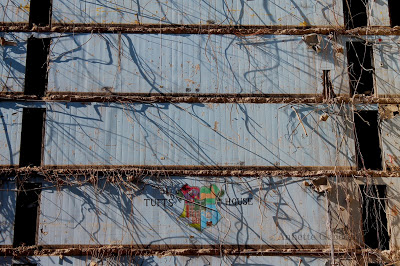 |
| Pierce Hall, in its current state of half demolition |
The Smart Museum’s current exhibit State of Mind: New California Art Circa 1970 showcases, among other works, the plain and simple photo books by Ed Ruscha. His small, seemingly simple accordion style photo book Every Building on Sunset Strip got me thinking. Back in 1966, when he self published it, it may have seemed rather ordinary. At first glance it still does. This guy goes out and takes head-on shots of every building on Sunset Strip and glues them together to create a miniature facsimile of the street, labeling each building with its house number. What’s so great about that, except that, when you think about it, it’s actually a pain to execute. But what else? What besides the ingenuity of having this idea and going to the trouble of actually doing it makes this art?
(I’m not going to hunt down permission to show this photo book, so please Click here for a photo of Every Building on Sunset Strip and some of the Ed Ruscha photos I’m referring to.)
 |
| What is currently left of Pierce Hall at 55th Street and University Ave. |
After going through the exhibit, we went on a quick photo jaunt along Hyde Park’s 55th Street, and it occurred to me that I could have taken the same kind of exacting photos of 55th Street that Ed Ruscha took of Sunset Strip when I first arrived here in 1988. What a historical document that would be now, and how interesting it would be to see how the street has changed! But of course I didn’t do that because back then I only took photos of special occasions and vacations, and didn’t know of Ed Ruscha, but mainly, 55th Street always seemed boring to me. Still does. But then I passed the ruin of the Pierce Hall dormitory on the corner of 55th Street and University Avenue, which is currently being torn down. That building has always been there in my 25 years here in Hyde Park. It was also, in my opinion, so 1950/60s unremarkable. Now it’s just about gone, and I wish I had photos of it from back in the day. We don’t build like that anymore.
All of Ed Ruscha’s systematic photos of buildings in Los Angeles, or 26 gas stations along Route 66, were plain shots when he took them in the ’60s, but now they are interesting, charming, and historical artifacts. No gas station looks like that anymore, nor do buildings have geometric roof decorations like they did in the ’60s. (Click here to see some of the photos I am talking about.)
 |
| The day I took these photos last week, the blue of the sky matched the blue of the wall’s exposed insulation. |
So I am wondering: Will what is boring to us today be interesting to us tomorrow? After all, my grandfather’s photos of Paris from 1937 are still a tourist’s photos of Paris, but they are very different from my photos from my first visit there in 1982, and many subsequent visits. They have historical significance now. For one, the cars parked in the streets in 1937 are way cooler than cars are now. Does that mean that cars from today seem cool 50 years from now? 70, 80 years from now? Does that mean they are worth documenting? After all, how precious has any photo of the Twin Towers become since 9/11! Any ordinary snapshot I see that shows them makes my heart sink a little, or skip a beat.
I know this documenting of the seemingly ordinary applies to writing memoir as well. Often, when I write, I hunt for mundane facts. I wish, for instance, that I had photos of the interior of my grandparents’ house in Liberec. Sadly, I don’t. I can’t describe what the rooms looked like. I can only glimpse the corner of a china cabinet, or a flowery wallpaper as background in family portraits. Because, back then, nobody thought to take photos of the inside of the house itself. Just documenting it? Who cares? It was so everyday back then. But now it is not.
 |
| Residence Halls at the University of Chicago house more than one “House,” i.e. a community of students. Here the emblem of the “Tufts House” is still hanging on. I’m sure many memories come with this sign. |
Amazingly, a friend of my grandmother understood this. A few years before my grandmother passed away, this lady gave me a little album, in which she had stuck photos of my grandmother’s apartment in Wiesbaden, the apartment I always knew her to live in, the apartment that was the mainstay of my childhood. As she handed it to me, she said, “It will be nice, one day, to have pictures of your grandmother’s place. Just the place, the way it used to be.” Turns out that that old lady knew something about photography, about art and about what might matter.

I somehow doubt cars from today will look cool eighty years from now. They built them to last eighty years back, but the ones today just aren't built that way.
Is it odd that I feel sorry for that building? It's in its death throes….
William – you are probably right – the cars nowadays simple won't last 50 years but even so, perhaps we will find them cool when we look at them decades later? Or our kids do?
And yes, I feel sorry for that building, too, even though I never cared for it much when it was "alive."
Ah, Annette. You always give us something to think about. You make the mundane full of thought. I'm trying to get my blogging mojo back because I've slipped in that regard. I try too hard or don't try enough lately. What I'm really trying to say is that I wish I had written this post.
Julie – thank you so much! It is always wonderfully rewarding to hear that a post resonates with a reader, especially a faithful one like you. I look forward to you getting your blogging mojo back.